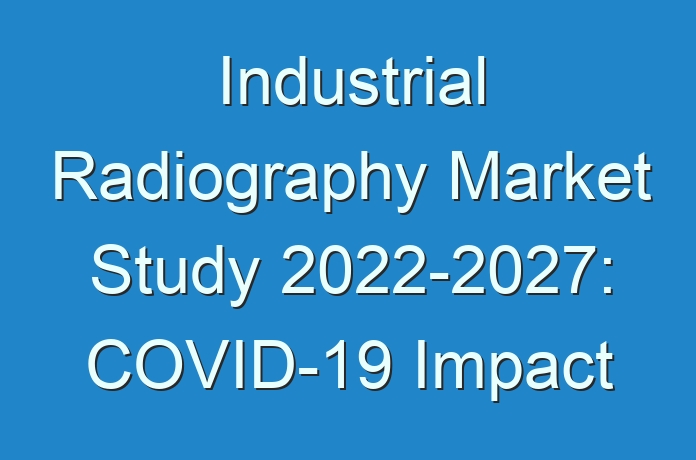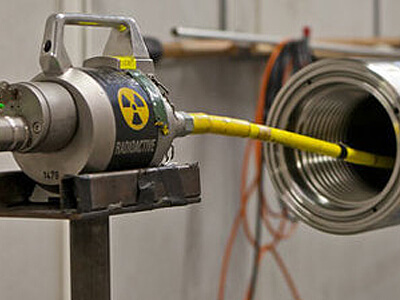
Industrial radiography is a nondestructive method of materials testing which is playing a significant role in the remarkable progress made in scientific technology and industry in the recent years. Radiation penetration technique is the most widely used nondestructive method employed for testing in industries, offering the advantages of high versatility, ability and reliability to provide a permanent information record. Industrial radiation is performed commonly by using two different sources of radiation, namely, Gamma ray sources and X-ray sources in order to inspect the internal flaws in products. These sources of radiation are used extensively for the examination of pipes and pressure vessels in chemical plants, aircraft and vehicles and gas and oil pipelines.
Industrial radiography is used by manufacturers for surface inspection and flaw or crack detection in their products. Gamma radiography is used in industries for quality control and safety assessment purposes. It is used widely in the petrochemical, building and chemical industries for radiographic inspection of boilers, pipes and structures where safety and economic consequences of failure can be critical. Industrial radiography is used in wide range of applications such as automation and transportation, aerospace, gas and petrochemical and manufacturing owing to the growing demand for high-quality and low-cost products. This method is deployed widely in the automotive sector and it has become one of the important tools for the automotive manufacturers to inspect products during their production and produce high-quality products with tighter tolerances.
Planning to lay down future strategy? Perfect your plan with our report sample here https://www.transparencymarketresearch.com/sample/sample.php?flag=S&rep_id=15497

Industrial Radiography Market: Drivers and Restraints
The factors which are primarily driving the global industrial radiography market are growing demand of industrial radiography in aerospace and automotive industries, strict safety regulations by various governments and need for accuracy of inspection with the integration of advanced software. The growing adoption of industrial radiography methods across its various application areas is helping to reduce wastage significantly along with improving the productivity of manufacturing plants. However, high level of risk associated with exposure radiation and high deployment costs of industrial radiography techniques might hamper the growth of the global market. Factors such as rapid industrialization in developing economies namely Asia Pacific and Middle East and Africa coupled with automation of inspection and testing process are offering potential growth opportunities to the global industrial radiography market.
Industrial Radiography Market: Segmentation
The global industrial radiography market can be segmented on the basis of imaging technique into digital radiography and film-based radiography. Digital radiography can be further classified into computed radiography, direct radiography and computed tomography. On the basis of application, the global market can be segmented into manufacturing, automotive, power generation, aerospace and gas and petroleum industries. In addition, the industrial radiography market can be geographically divided broadly into four regions, namely: North America, Europe, Asia Pacific, RoW (includes Middle East and Africa and South America). The industrial radiography market is witnessing steady growth over the past decade in North America and its dominance is expected to continue throughout the forecast period. Moreover, the global market is expected to expand in the developing regions such as Asia Pacific.
The major players in the industrial radiography market are General Electric (U.S.), Anritsu Corporation (Japan), FujiFilm Holdings Corporation (Japan), PerkinElmer, Inc. (U.S.), Shimadzu Corporation (Japan), 3DX-RAY LTD. (U.K.), Bosello High Technology srl (Italy), COMET Holding AG (Switzerland), Nikon Corporation (Japan) and Mettler-Toledo International Inc. (Switzerland) among others.
The report offers a comprehensive evaluation of the market. It does so via in-depth qualitative insights, historical data, and verifiable projections about market size. The projections featured in the report have been derived using proven research methodologies and assumptions. By doing so, the research report serves as a repository of analysis and information for every facet of the market, including but not limited to: Regional markets, technology, types, and applications.
Looking for exclusive market insights from business experts? Buy Now Report here https://www.transparencymarketresearch.com/checkout.php?rep_id=15497<ype=S
The study is a source of reliable data on:
- Market segments and sub-segments
- Market trends and dynamics
- Supply and demand
- Market size
- Current trends/opportunities/challenges
- Competitive landscape
- Technological breakthroughs
- Value chain and stakeholder analysis
The regional analysis covers:
- North America (U.S. and Canada)
- Latin America (Mexico, Brazil, Peru, Chile, and others)
- Western Europe (Germany, U.K., France, Spain, Italy, Nordic countries, Belgium, Netherlands, and Luxembourg)
- Eastern Europe (Poland and Russia)
- Asia Pacific (China, India, Japan, ASEAN, Australia, and New Zealand)
- Middle East and Africa (GCC, Southern Africa, and North Africa)
The report has been compiled through extensive primary research (through interviews, surveys, and observations of seasoned analysts) and secondary research (which entails reputable paid sources, trade journals, and industry body databases). The report also features a complete qualitative and quantitative assessment by analyzing data gathered from industry analysts and market participants across key points in the industry’s value chain.
A separate analysis of prevailing trends in the parent market, macro- and micro-economic indicators, and regulations and mandates is included under the purview of the study. By doing so, the report projects the attractiveness of each major segment over the forecast period.





